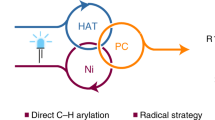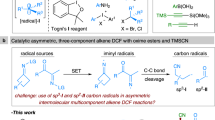Abstract
The engineering of molecular catalysts in homogeneous catalysis enables new catalytic modes, which leads to efficient synthetic transformations. In this regard, the design of ligands for transition metal catalysis has played a major role. In transition metal catalysed reactions, olefins can serve as steering ligands by tuning the electronic and steric nature of the metal centre. Here we report unstrained olefin ligands that bear a P or S coordination site for use in the Pd-catalysed Catellani reaction. This olefin ligand shows a covalent catalytic function and enables an efficient ipso,ortho-difunctionalization of iodoarenes. Mechanistic analysis reveals a reversible covalent bonding between the substrate and the cycloolefin unit of the ligand, which forms key organopalladium intermediates to enable a new reactivity. Our results demonstrate a design concept that employs hybrid cycloolefin ligands as a covalent catalytic module, which opens up possibilities for further cooperative catalysis with other transition metal–olefin hybrids.

This is a preview of subscription content, access via your institution
Access options
Subscribe to this journal
Receive 12 digital issues and online access to articles
$119.00 per year
only $9.92 per issue
Buy this article
- Purchase on Springer Link
- Instant access to full article PDF
Prices may be subject to local taxes which are calculated during checkout




Similar content being viewed by others
Data availability
The data supporting the findings of this study are available within the paper and its Supplementary Information. Crystallographic data for the structures reported in this Article have been deposited at the Cambridge Crystallographic Data Centre, under deposition numbers CCDC 2060007 (9) and 2060009 (11). Copies of the data can be obtained free of charge via https://www.ccdc.cam.ac.uk/structures/.
References
Tsuji, J. Transition Metal Reagents and Catalysts: Innovations in Organic Synthesis (John Wiley, 2002).
Stradiotto, M. & Lundgren, R. J. Ligand Design in Metal Chemistry: Reactivity and Catalysis (Wiley-VCH, 2016).
Glorius, F. Chiral olefin ligands—new ‘spectators’ in asymmetric catalysis. Angew. Chem. Int. Ed. 43, 3364–3366 (2004).
Defieber, C., Grützmacher, H. & Carreira, E. M. Chiral olefins as steering ligands in asymmetric catalysis. Angew. Chem. Int. Ed. 47, 4482–4502 (2008).
Feng, X. & Du, H. Synthesis of chiral olefin ligands and their application in asymmetric catalysis. Asian J. Org. Chem. 1, 204–213 (2012).
Li, Y. & Xu, M.-H. Simple sulfur–olefins as new promising chiral ligands for asymmetric catalysis. Chem. Commun. 50, 3771–3782 (2014).
Dong, H.-Q., Xu, M.-H., Feng, C.-G., Sun, X.-W. & Lin, G.-Q. Recent applications of chiral N-tert-butanesulfinyl imines, chiral diene ligands and chiral sulfur–olefin ligands in asymmetric synthesis. Org. Chem. Front. 2, 73–89 (2015).
van der Vlugt, J. I. Cooperative catalysis with first-row late transition metals. Eur. J. Inorg. Chem. 2012, 363–375 (2012).
Lyaskovskyy, V. & de Bruin, B. Redox non-innocent ligands: versatile new tools to control catalytic reactions. ACS Catal. 2, 270–279 (2012).
Trincado, M. & Grützmacher, H. in Cooperative Catalysis (ed. Peters, R.) 67–110 (Wiley-VCH, 2015).
Berben, L. A., de Bruin, B. & Heyduk, A. F. Non-innocent ligands. Chem. Commun. 51, 1553–1554 (2015).
Catellani, M. Catalytic multistep reactions via palladacycles. Synlett 2003, 0298-0313 (2003).
Catellani, M., Motti, E. & Della Ca', N. Catalytic sequential reactions involving palladacycle-directed aryl coupling steps. Acc. Chem. Res. 41, 1512–1522 (2008).
Martins, A., Mariampillai, B. & Lautens, M. Synthesis in the key of Catellani: norbornene-mediated ortho C–H functionalization. Top. Curr. Chem. 292, 1–33 (2010).
Della Ca', N., Fontana, M., Motti, E. & Catellani, M. Pd/norbornene: a winning combination for selective aromatic functionalization via C–H bond activation. Acc. Chem. Res. 49, 1389–1400 (2016).
Wegmann, M., Henkel, M. & Bach, T. C–H alkylation reactions of indoles mediated by Pd(II) and norbornene: applications and recent developments. Org. Biomol. Chem. 16, 5376–5385 (2018).
Wang, J. & Dong, G. Palladium/norbornene cooperative catalysis. Chem. Rev. 119, 7478–7528 (2019).
Gu, Z., Zhao, K. & Ding, L. Development of new electrophiles in palladium/norbornene-catalyzed ortho-functionalization of aryl halides. Synlett 30, 129–140 (2018).
Catellani, M., Frignani, F. & Rangoni, A. A complex catalytic cycle leading to a regioselective synthesis of o,o′-disubstituted vinylarenes. Angew. Chem. Int. Ed. 36, 119–122 (1997).
Lautens, M. & Piguel, S. A new route to fused aromatic compounds by using a palladium-catalyzed alkylation–alkenylation sequence. Angew. Chem. Int. Ed. 39, 1045–1046 (2000).
Bressy, C., Alberico, D. & Lautens, M. A route to annulated indoles via a palladium-catalyzed tandem alkylation/direct arylation reaction. J. Am. Chem. Soc. 127, 13148–13149 (2005).
Li, R. & Dong, G. Structurally modified norbornenes: a key factor to modulate reaction selectivity in the palladium/norbornene cooperative catalysis. J. Am. Chem. Soc. 142, 17859–17875 (2020).
Dong, Z., Wang, J., Ren, Z. & Dong, G. Ortho C–H acylation of aryl iodides by palladium/norbornene catalysis. Angew. Chem. Int. Ed. 54, 12664–12668 (2015).
Shen, P.-X., Wang, X.-C., Wang, P., Zhu, R.-Y. & Yu, J.-Q. Ligand-enabled meta-C–H alkylation and arylation using a modified norbornene. J. Am. Chem. Soc. 137, 11574–11577 (2015).
Liu, J. et al. Pd(II)/norbornene-catalyzed meta-C–H alkylation of nosyl-protected phenylalanines. J. Org. Chem. 83, 13211–13216 (2018).
Liu, Z.-S. et al. Palladium/norbornene cooperative catalysis to access tetrahydronaphthalenes and indanes with a quaternary center. ACS Catal. 8, 4783–4788 (2018).
Cai, W. & Gu, Z. Selective ortho thiolation enabled by tuning the ancillary ligand in palladium/norbornene catalysis. Org. Lett. 21, 3204–3209 (2019).
Ding, Y.-N. et al. Palladium-catalyzed ortho-C–H glycosylation/ipso-alkenylation of aryl iodides. J. Org. Chem. 85, 11280–11296 (2020).
Ye, J. & Lautens, M. Palladium-catalysed norbornene-mediated C–H functionalization of arenes. Nat. Chem. 7, 863–870 (2015).
Mellah, M., Voituriez, A. & Schulz, E. Chiral sulfur ligands for asymmetric catalysis. Chem. Rev. 107, 5133–5209 (2007).
Gorsline, B. J., Wang, L., Ren, P. & Carrow, B. P. C–H alkenylation of heteroarenes: mechanism, rate, and selectivity changes enabled by thioether ligands. J. Am. Chem. Soc. 139, 9605–9614 (2017).
Naksomboon, K., Valderas, C., Gómez-Martínez, M., Álvarez-Casao, Y. & Fernández-Ibáñez, M. A. S,O-ligand-promoted palladium-catalyzed C–H functionalization reactions of nondirected arenes. ACS Catal. 7, 6342–6346 (2017).
Wang, L. & Carrow, B. P. Oligothiophene synthesis by a general C–H activation mechanism: electrophilic concerted metalation-deprotonation (eCMD). ACS Catal. 9, 6821–6836 (2019).
Gao, Q. et al. Modular dual-tasked C–H methylation via the Catellani strategy. J. Am. Chem. Soc. 141, 15986–15993 (2019).
Shi, G., Shao, C., Ma, X., Gu, Y. & Zhang, Y. Pd(II)-catalyzed Catellani-type domino reaction utilizing arylboronic acids as substrates. ACS Catal. 8, 3775–3779 (2018).
Catellani, M., Motti, E. & Minari, M. S. Symmetrical and unsymmetrical 2,6-dialkyl-1,1′-biaryls by combined catalysis of aromatic alkylation via palladacycles and Suzuki-type coupling. Chem. Commun. 2000, 157–158 (2000).
Ye, C., Zhu, H. & Chen, Z. Synthesis of biaryl tertiary amines through Pd/norbornene joint catalysis in a remote C–H amination/Suzuki coupling reaction. J. Org. Chem. 79, 8900–8905 (2014).
Wilhelm, T. & Lautens, M. Palladium-catalyzed alkylation–hydride reduction sequence: synthesis of meta-substituted arenes. Org. Lett. 7, 4053–4056 (2005).
Motti, E., Rossetti, M., Bocelli, G. & Catellani, M. Palladium catalyzed multicomponent reactions in ordered sequence: new syntheses of o,o′-dialkylsubstituted diarylacetylenes and diarylalkylidenehexahydromethanofluorenes. J. Organomet. Chem. 689, 3741–3749 (2004).
Wang, J., Li, R., Dong, Z., Liu, P. & Dong, G. Complementary site-selectivity in arene functionalization enabled by overcoming the ortho constraint in palladium/norbornene catalysis. Nat. Chem. 10, 866–872 (2018).
Lv, W., Chen, Y., Wen, S., Ba, D. & Cheng, G. Modular and stereoselective synthesis of C-aryl glycosides via Catellani reaction. J. Am. Chem. Soc. 142, 14864–14870 (2020).
Dong, Z. & Dong, G. Ortho vs ipso: site-selective Pd and norbornene-catalyzed arene C–H amination using aryl halides. J. Am. Chem. Soc. 135, 18350–18353 (2013).
Zhou, P.-X. et al. Palladium-catalyzed acylation/alkenylation of aryl iodide: a domino approach based on the Catellani–Lautens reaction. ACS Catal. 5, 4927–4931 (2015).
Acknowledgements
Financial support was provided by the National Natural Science Foundation of China (grant number 21822304 to L.J.). M.-T. Zhang is acknowledged for insightful discussions. We thank F.-Y. Wang for performing a control experiment with substrate 1n and X. Xu for repeating the synthesis of complexes 9 and 11. The technological platform of CBMS is acknowledged for providing instrumentation.
Author information
Authors and Affiliations
Contributions
L.J. and Y.-X.Z. conceived the work and designed the experiments. Y.-X.Z. performed the laboratory experiments. L.J. and Y.-X.Z. analysed the data and co-wrote the manuscript.
Corresponding author
Ethics declarations
Competing interests
The authors declare no competing interests.
Peer review
Peer review information
Nature Synthesis thanks M. Ángeles Fernández-Ibáñez and the other, anonymous, reviewer(s) for their contribution to the peer review of this work. Thomas West was the primary editor on this article and managed its editorial process and peer review in collaboration with the rest of the editorial team.
Additional information
Publisher’s note Springer Nature remains neutral with regard to jurisdictional claims in published maps and institutional affiliations.
Supplementary information
Supplementary Information
Detailed experimental procedures and characterization data.
Supplementary Data 1
Crystallographic data of complex 9 (CCDC 2060007).
Supplementary Data 2
Structure factors for crystallographic complex 9 (CCDC 2060007).
Supplementary Data 3
Crystallographic data of complex 11 (CCDC 2060009).
Supplementary Data 4
Structure factors for crystallographic complex 11 (CCDC 2060009).
Rights and permissions
About this article
Cite this article
Zheng, YX., Jiao, L. Hybrid cycloolefin ligands for palladium–olefin cooperative catalysis. Nat Synth 1, 180–187 (2022). https://doi.org/10.1038/s44160-021-00019-8
Received:
Accepted:
Published:
Issue Date:
DOI: https://doi.org/10.1038/s44160-021-00019-8



